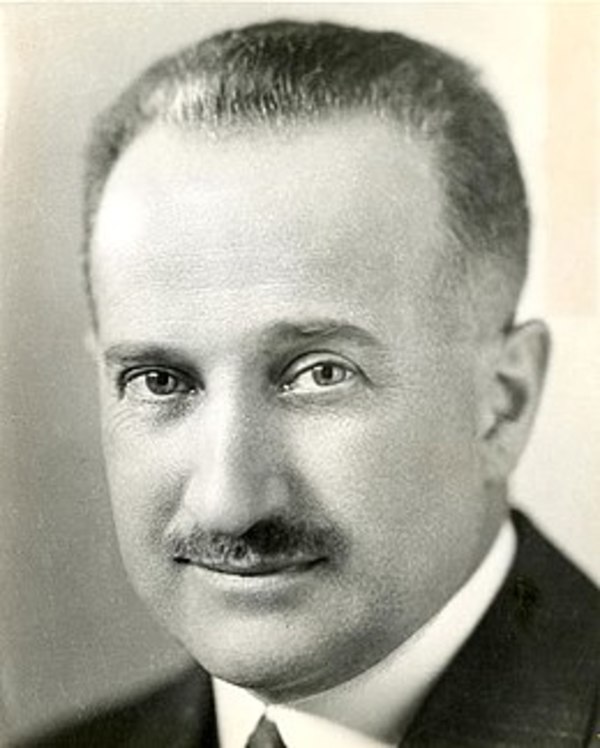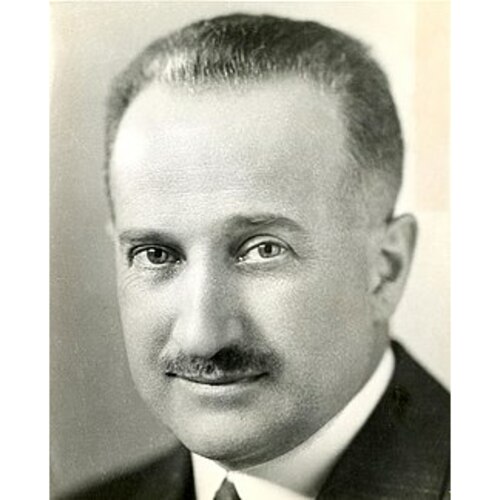
Source: Courtesy of Wikimedia Commons
PRÉVOST, ALBERT (baptized Louis-Elzéar-Albert), neurologist, forensic pathologist, and professor; b. 5 Aug. 1881 in Montreal, son of Alexis-Édouard-Armand Prévost, a merchant, and Joséphine-Ida Beaudry; m. there 26 Aug. 1909 Thérèse Leduc, and they had four children; d. there 4 July 1926 as a result of an accident.
Albert Prévost grew up in a well-to-do family that had been active in the Montreal business community for two generations. His father and his paternal grandfather, Amable-Cyprien Prévost, owned a number of dry goods stores there. His maternal grandfather, Jean-Baptiste Beaudry, was a merchant, landowner, and banker in Montreal.
In 1895 Prévost began his classical studies at the Collège Sainte-Marie, where one of his classmates was Athanase David*, who would become the provincial secretary. Short, stocky, and of athletic build, Prévost reportedly began to display exceptional ability in sports at that time. After his graduation in June 1903, he enrolled in medicine at the Montreal branch of the Université Laval; he obtained his medical degree “with distinction” four years later. A man of independent means, he went on to Paris to specialize. There he would meet his future wife, the daughter of Joseph Leduc of Montreal, a physician who owned the chain of pharmacies bearing his name. In 1909 he also came across in Paris a boyhood friend with whom he would remain in close touch, Édouard Montpetit*, who later founded the École des Sciences Sociales, Économiques et Politiques at the Université de Montréal.
Prévost’s original intention was to obtain a prestigious position as an intern in the hospitals of Paris, as his uncle Dr Azarie Brodeur had earlier done. He quickly discovered, however, that his own field of interest was neurology. Under the guidance of such teachers as Pierre Marie, André Thomas, Joseph Babinski, and especially Jules Déjerine, all former students of the famous Jean-Martin Charcot, Prévost combined clinical observation of patients at the Salpêtrière hospital with laboratory research into the anatomy and physiology of the prime functions of the brain. He also spent some time at the Infirmerie du Dépôt de la Préfecture de Police, studying under psychiatrists Ernest Dupré and Gaëtan Gatian de Clérambault. This work gained him the title of forensic pathologist from the Université de Paris, probably at the end of 1913. He then returned to Montreal, where in February 1914 he joined the staff of the dispensary for diseases of the nervous system at Notre-Dame Hospital. Around the same time he began to take part in the activities of the Société Médicale de Montréal. On 4 May 1914 he also became associate professor of neurology in the faculty of medicine at the Université Laval in Montreal and conducted clinics in diseases of the nervous system at Notre-Dame. During the same period he was appointed consulting physician at the Hôpital Saint-Jean-de-Dieu as well. In addition, he was a member of the medical board of the Institut Bruchési from 1915 to 1924. In 1918 Prévost became head of the neurological department of Notre-Dame Hospital, replacing Georges Villeneuve, who had died that year, and he retained this post for the rest of his life. On 8 April 1918 he was also appointed to the first chair of neurology at the Université Laval in Montreal, with tenure. He quickly gained a reputation as one of the best professors on the faculty, his lectures and theoretical courses being valued as much by students and nurses as by his colleagues. According to Antonio Barbeau, who had studied under him, he was an articulate man, “equally rich in content and in form.”
Prévost showed endless devotion to his patients and had an enterprising spirit uncommon among French-speaking physicians at that time. In 1919, realizing that large hospitals were unsuited to the needs of patients suffering from neuroses (nervous conditions increasingly frequent from the time of World War I), Prévost decided to set up a private clinic in the quiet Montreal suburb of Cartierville, near the Rivière des Prairies. This clinic became known as the Sanatorium Prévost. He bought a three-storey house from Raoul-Ovide Grothé, an important Montreal businessman, in 1919 and renovated it at his own expense in order to accommodate ten patients. With the acquisition in 1921 of a dwelling nearby, the property of contractor Félix-Avila Grothé, Prévost could house 23 patients in his sanatorium. Although electrotherapy equipment was installed that year, in keeping with the French theories of the time he used psychotherapy to treat his patients. In this respect the Sanatorium Prévost differed markedly from similar institutions such as the Sanatorium de Trois-Rivières, which had been founded in 1896 by Dr Charles-Numa De Blois, where the primary emphasis was on the use of physical procedures (electrotherapy, hydrotherapy, X-rays, and so forth) to treat depression, drug addiction, and minor psychoses. Under the direction of Charlotte Tassé, the superintendent, and Dr Edgar Langlois, Prévost’s first disciple and colleague, this private institution would outlast its founder. After World War II it would become an important teaching centre in the fields of neurology and psychiatry.
As a forensic pathologist, Prévost was frequently called on by the courts. The most famous trial in which he took part as an expert witness was probably that of Marie-Anne Houde, the stepmother of Aurore Gagnon*, known as Aurore the martyred child, in 1920.
In January 1925 Prévost and 18 other French-speaking physicians from Montreal came onto the board of directors of L’Union médicale du Canada (Montréal). This new shareholders’ group sought to help develop hospital centres and advance university teaching in French Canada, collaborate in the scientific progress of learned societies, and take part in planning the conferences of the Association des Médecins de Langue Française de l’Amérique du Nord, of which Prévost had been a member since 1922. After the reorganization of the board, closer relations arose between French-speaking physicians in Europe and those in Canada. Prévost was getting ready to attend the 30th session of the Congrès Annuel des Médecins Aliénistes et Neurologistes de France et des Pays de Langue Française, which was to be held in Switzerland, in Lausanne and Geneva from 2 to 7 Aug. 1926, when he suffered an accident that would prove fatal.
It seems odd that Prévost wrote very little. Of his papers to the Société Médicale de Montréal, which were sometimes presented in collaboration with colleagues at Notre-Dame, nothing is left except summaries published in L’Union médicale du Canada. Undoubtedly Prévost had given clinical descriptions of the principal nervous disorders of organic origin, but he apparently made his main contribution through the tissues he sectioned from the brain or the spinal cord, which made it possible to confirm his diagnoses or those of his colleagues.
Prévost belonged to a number of social clubs, including the Club Saint-Denis, the Cercle Universitaire de Montréal, and the Knights of Columbus. Keen on exercise, he was also a member of the golf club in Laval-sur-le-Lac (Laval) and the Club Chapleau, a private hunting and fishing establishment.
On 4 July 1926 Albert Prévost, who was then at the height of his career, died at the Royal Victoria Hospital in Montreal from the effects of an automobile accident that had occurred the night before on the road between L’Assomption and Saint-Paul-l’Ermite (Le Gardeur). He had been returning from a consultation in Berthier (Berthierville) with Dr D. Alfred Benoit, who was seriously injured. Prévost’s impressive funeral service was attended by many of the leading citizens of Montreal.
Albert Prévost is the author of “Résumé pratique du traitement de la syphilis,” L’Union médicale du Canada (Montréal), 49 (1920): 612–17.
ANQ-M, CE601-S33, 8 août 1881. Arch. de l’Univ. de Montréal, E 38 (faculté de médecine), procès-verbaux du conseil de la faculté de médecine de l’univ. Laval à Montréal, 1914–18. BCM-G, RBMS, Saint-Louis-de-France (Montréal), 26 août 1909 (mfm.). Le Devoir, 5, 10 juill., 25 sept. 1926. La Presse, 21 avril 1920; 5, 7 juill. 1926. Antonio Barbeau, “Université de Montréal, chaire de neurologie de la faculté de médecine: leçon inaugurale du professeur Antonio Barbeau,” L’Union médicale du Canada, 69 (1940): 117–25. E.-P. Benoît, “Nécrologie: Albert Prévost,” L’Union médicale du Canada, 55 (1926): 465–66. Wilfrid Derome, “Le professeur Albert Prévost,” L’Union médicale du Canada, 55: 467–70. Jocelyne Dion, Pavillon Albert-Prévost, 1919–1994: 75 ans (Montréal, [1994]). J.-E. Dubé, “Nos hôpitaux: le passé, leur évolution, le présent,” L’Union médicale du Canada, 61 (1932): 148–234. Hôpital Notre-Dame, Rapport annuel (Montréal), 1914–26. Madeleine [A.-M. Gleason], “Ceux qui s’en vont . . . ,” La Rev. moderne (Montréal), 7 (1925–26), no.10: 10. Édouard Montpetit, “Albert Prévost,” Rev. trimestrielle canadienne (Montréal), 12 (1926): 361–67. Univ. de Montréal, Annuaire, 1920–22. Univ. Laval à Montréal, Annuaire, 1904–19.
Cite This Article
Guy Grenier, “PRÉVOST, ALBERT (baptized Louis-Elzéar-Albert),” in Dictionary of Canadian Biography, vol. 15, University of Toronto/Université Laval, 2003–, accessed December 14, 2025, https://www.biographi.ca/en/bio/prevost_albert_15E.html.
The citation above shows the format for footnotes and endnotes according to the Chicago manual of style (16th edition). Information to be used in other citation formats:
| Permalink: | https://www.biographi.ca/en/bio/prevost_albert_15E.html |
| Author of Article: | Guy Grenier |
| Title of Article: | PRÉVOST, ALBERT (baptized Louis-Elzéar-Albert) |
| Publication Name: | Dictionary of Canadian Biography, vol. 15 |
| Publisher: | University of Toronto/Université Laval |
| Year of publication: | 2005 |
| Year of revision: | 2005 |
| Access Date: | December 14, 2025 |



